Next year, I am publishing a book on the tiltrotor enterprise. I have been interviewing and engaging with Marines using the aircraft since 2007, the first time I flew on the aircraft.
There seems to be a cottage industry of folks writing about the difficulty of flying the aircraft and implying that this somehow suggests it is too dangerous for the missions it has been successfully doing since its first appearance in Iraq in 2007.
My own observation has been that training and experience do matter with a combat aircraft which is unique as the Osprey is, for after all you need to know how to fly a plane, how to fly a rotorcraft and how to transition from one to the other and vice versa.
I wanted to talk with an experienced Osprey practitioner with regard to the importance of training, muscle memory and pilot competence and was fortunate to talk on November 20, 2024 with a Marine whom I had the opportunity to interview several years ago.
In a 2016 article which I wrote with my colleague Ed Timperlake, we talked with the then XO of MAWTS-1, Lt Col “Cowboy” Nelson. He had been on the deployment to Afghanistan under the command of Lt Col Bianca when I interviewed Lt Col Bianco after an Osprey raid in 2010.
In the earlier 2010 interview conducted by telephone when the squadron was in Afghanistan, Lt. Col. Bianca highlighted a number of key contributions of the aircraft to the fight.
The most compelling point underscored by the squadron commander is how, in effect, the Osprey has inverted infrastructure and platform.
Normally, the infrastructure shapes what the platform can do. Indeed, a rotorcraft or a fixed wing aircraft can operate under specific circumstances.
With the range and speed of the Osprey aircraft, the plane shapes an overarching infrastructure allowing the ground forces to range over all of Afghanistan, or to be supported where there are no airfields, or where distributed forces need support.
The envelopment role of the Osprey is evident in Afghanistan as well, whereby the Osprey can provide the other end of the operational blow for the ground or rotorcrafts in hot pursuit of Taliban.
The Osprey can move seamlessly in front of rotorcraft and land forces, allowing the pursuit of different lines of attack. The envelopment role was not the focus of the interview because of security considerations, but anecdotal evidence suggests such an emerging role.

When we talked to “Cowboy” during our visit to MAWTS-1 in 2016, he was applying his by then extensive experience with the Osprey and connecting to the then new kid on the block, namely the F-35s and referred the new generation of Marines working the intersection of these two revolutionary capabilities as follows:
Cowboy: The new generation is so technologically sophisticated that they will thrive in the evolving digital environment – of which the F-35 is a key element.
Connecting with him again, now eight years later, we returned to a discussion of the Osprey and the importance of generating the flight hours and training commensurate with the combat benefits which the aircraft delivers to the Marines and the joint force.
He started by underscoring the importance of squadron readiness when operating the Osprey, which of course, is true across the flying community. And readiness and training have not been high on recent Administration’s shopping lists.
Cowboy: It is a resourcing issue. If you don’t resource and give a squadron the people they need, the parts they need to fix something, the airplanes aren’t going to fly effectively.
And I think that goes back to the flying hours issue.
The trend has been to lower the number of flying hours which Osprey pilots have, which has a direct impact on readiness.
Nothing replaces air sense, by which I mean being off the ground in the air.
It hones your decision making, your experience and your skills as a pilot,
You know, when I was a young man and started out in helicopters, before I went to MAWTS-1, I don’t think that I had a year where I didn’t fly more than 300 hours.
An average year for a V-22 pilot now is probably closer to 150 hours.
My CO’s had 3000-5000 flight hours and today I think we are seeing many with much few flight hours when they take command.
There is little doubt that the question of flight hours contributes significantly to the current mishap rate.
Are we putting pilots in a position where they are more likely to make mistakes because their skills are not refined?
We then focused on a core flying challenge which requires significant training time and that is CALs or (confined area landings).
I once experienced at New River one afternoon 22 landings in a V-22 which is very different from a rotorcraft because the pilot is using the advantages of being a plane to adjust where he will approach the landing zone and then shifts to rotorcraft mode to land.
This is a key area where he felt that flight time should be increased in operating and training with the aircraft.
Cowboy: Pilots need the muscle memory of getting into landing environments.
And it’s further complicated when you get in the dust.
We’ve got great simulators, but nothing will replace the time in the airplane for flying and building muscle memory.
Featured photo: An MV-22B Osprey with Marine Medium Tiltrotor Squadron 262, 1st Marine Aircraft Wing, lands at Chitose Air Base, Hokkaido, Japan, Feb. 4, 2020. The arrival of the Osprey to exercise Northern Viper brings an added element, further advancing opportunities for continued bilateral coordination between the U.S. Marine Corps and the Japan Ground Self-Defense Force. Northern Viper is a regularly scheduled training exercise that is designed to enhance the interoperability of the U.S. and Japan Alliance by allowing Marine Air-Ground Task Forces from III Marine Expeditionary Force to maintain their lethality and proficiency in MAGTF Combined Arms Operations in cold weather environments. (U.S. Marine Corps photo by Lance Cpl. Dylan Hess)
Kirk “Cowboy” Nelson
He is Director of Advanced Training Systems, Xiphos Partners
Kirk “Cowboy” Nelson serves on the Xiphos Partners Team as Director of the Advanced Training Systems business unit and Program Manager of the JTAC virtual training system (JVT). In this role he is responsible for the transition of the JVT training system to a Program of Record as well as the development of new and related Advanced Training products.
Kirk came to Xiphos from Bell Textron. He served as the Director Sustainment, V-22 from May of 2020 until April of 2023.
In this role, Kirk is responsible for multiple Performance Based Logistics contracts that exceeded all performance metrics during his tenure. Kirk led his team in expanding the PBL business at Bell and the V-22 sustainment team was routinely recognized for their superior support to the warfighter. He was also responsible for Bell’s Fleet Service team which included over 100 Field Service Representatives.
He previously held the position of Manager, Flight Operations Maintenance, at the Bell Flight Research Center. His responsibilities included supporting aircraft maintenance and logistics for Bell experimental flight test. Kirk supported the 525 and the V-280 programs during his tenure.
Before joining Bell, LtCol Nelson was the Commanding Officer of VMM-266 where he was responsible for the tactical employment of 12 MV-22B/C aircraft. As Commander, he led his squadron in operations across North and West Africa. His squadron was the first to deploy to both Ghana and Gabon for an extended period in support of both training and contingency operations.
He also established the MV-22 curriculum and was the first MV-22 MAWTS-1 instructor.
Kirk also deployed and flew combat missions in both Iraq and Afghanistan. He was a member of the first MV-22 squadron to operate in Afghanistan.
Kirk enlisted in the Marine Corps and became a CH-46E mechanic and was later selected to attend the United States Naval Academy.
He earned a Bachelor of Science degree in History and was commissioned into the United States Marine Corps.
He went on to serve 24 years in Marine Aviation and graduated from multiple military training courses.


